- What We Do
- Agriculture and Food Security
- Democracy, Human Rights and Governance
- Economic Growth and Trade
- Education
- Ending Extreme Poverty
- Environment and Global Climate Change
- Gender Equality and Women's Empowerment
- Global Health
- Water and Sanitation
- Working in Crises and Conflict
- U.S. Global Development Lab
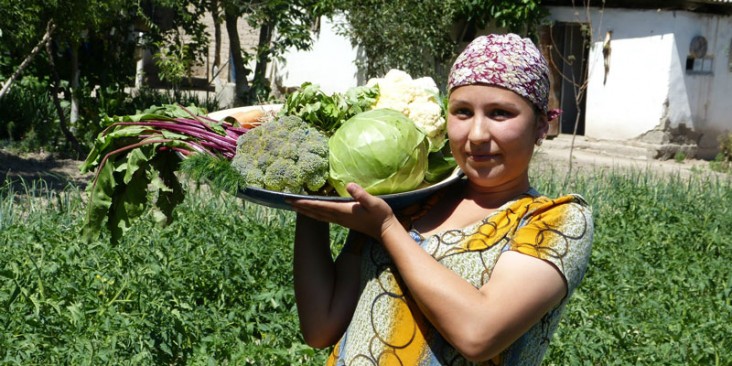
Background
At a Glance
- Background
- Beneficiary Targeting
- Intervention Approach
- Commercialization of Food
- Monitoring and Evaluation
- Next Steps
- References
View the PDF [PDF, 501KB].
The nexus of agriculture and nutrition programming is increasingly recognized as important for achieving the ambitious goals of the Feed the Future Initiative and the U.S. Agency for International Development (USAID) Multi-Sectoral Nutrition Strategy. Consistent with this broad goal of multi-sectoral integration, this discussion paper focuses more narrowly on making agricultural market development activities more nutrition-sensitive. Both agricultural market development and nutrition activities have their own established principles, standards, and practices. When the two disciplines come together in design and implementation, there are two notable results:
- Areas of convergence – where the principles or practices of nutrition and agricultural market development activities are complementary and create synergy
- Areas of tension – where the principles or practices of nutrition and agricultural market development activities are at odds.
Areas of potential convergence and tension create opportunities and challenges in the design and implementation of nutrition-sensitive agricultural market development activities. This paper is an initial attempt to describe four areas of convergence and tension: (1) beneficiary targeting; (2) intervention approach; (3) commercialization of food; and (4) monitoring and evaluation. Lacking a robust evidence base, this paper does not prescribe solutions to identified tensions—which, in any case, are likely to be highly context-specific—but suggests factors to consider in the design of nutrition-sensitive agricultural market development activities.
Box 1: Key Definitions
Market system: A dynamic space—incorporating resources, roles, relationships, rules, and results—in which private and public actors collaborate, coordinate, and compete for the production, distribution, and consumption of goods and services.
Market systems development: An approach that uses the facilitation of private and public actors to support the emergence of competitive, inclusive, and resilient market systems (Campbell 2014). Read more here.
Nutrition-sensitive: Addressing the underlying and systemic causes of malnutrition. Nutrition-sensitive agriculture must have a nutrition goal, activity, and indicator (USAID 2014). Read more here.
The 1,000-day window of opportunity: The 1,000 days from pregnancy to a child's second birthday is the most critical time for positive impact on a child's cognitive, intellectual, and physical development. Good nutrition in the first 1,000 days lays the foundation for health, development, and even prosperity for the next generation (USAID 2014).
1. Beneficiary Targeting
Feed the Future nutrition-specific activities target pregnant and lactating women (PLW) and children under the age of two as the subset of nutritionally vulnerable groups where there is the greatest opportunity for reducing chronic malnutrition. Many of these women and children live in households that lack resources, are risk-averse, or have opportunity costs that preclude them from participating in agricultural market development activities.
Agricultural market development activities work with a range of private- and public-sector market actors, but typically target smallholder farmers producing, or having the potential to produce, a marketable surplus. Some of these farmers are PLW, and many are from households that include PLW and children under two years of age. Market systems development activities use facilitation1 as an implementation approach, which generally includes encouraging the self-selection of participants; for example, smallholder farmers opt in to interventions and invest their own time and resources to access activity support and services. Those who self-select are typically less economically vulnerable and more able to assume risk and investments. A focus on marketable surplus and use of self-selection for agricultural market development activities, therefore, often excludes the poorest households.
Convergences and Tensions
Improving the productivity, incomes, skills, and knowledge of smallholder farmers through agricultural market development activities should improve the nutritional status of their household members, including those who fall within the most nutritionally vulnerable groups. However, the causal link between improvements in productivity, incomes, skills, and knowledge at the smallholder-farmer level and improvements in household members' nutritional status cannot be assumed (and has not been proven in several studies).2
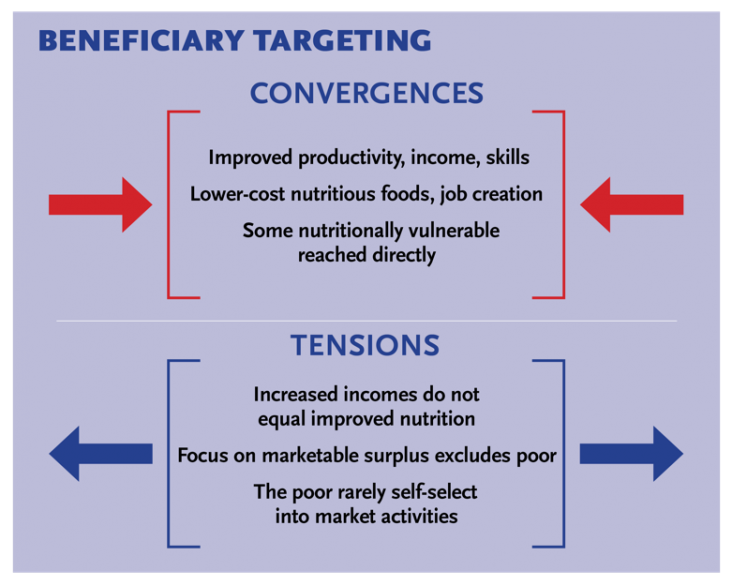
While households that self-select into market development programs may include PLW, such programs do not target them specifically as PLW, so their nutritional needs may not be met. In addition, many other PLW and children under two in the general population will not be included. For these reasons, self-selection into agriculture market development activities is an imperfect way to target nutrition activities.
Resource-poor mothers and caregivers and their households may benefit from a greater availability and/or lower cost of nutritious foods as a result of agricultural development activities. A few PLW may also benefit as laborers or service providers, but a typical agriculture activity will fail to reach many nutritionally vulnerable women from the poorest households.
Market development and nutrition-sensitive agricultural activities both target men and women to ensure that women are economically empowered but not overburdened with responsibilities for agricultural labor, income generation, food preparation, and child care.
Implications
Although there is often overlap between the economically vulnerable people participating in market development activities and people who are nutritionally vulnerable, the two groups are not the same. Activities, therefore, need to clearly define target populations, and understand the ways in which they are vulnerable. Where there is overlap between people who are economically and nutritionally vulnerable, activities to mitigate these two vulnerabilities should be co-located.
Box 2: Push/Pull Approach
A push/pull approach sequences and layers both push strategies, to build the capacities of the extreme poor to engage in markets, and pull strategies, to expand the diversity and quality of economic opportunities accessible to them. Push strategies include interventions to build household or community assets, improve linkages to social protection, build market readiness skills, and strengthen household capacity to manage risk (e.g., through savings mechanisms). Pull strategies include interventions to lower barriers to market entry (e.g., through group purchasing and marketing), extend services (e.g., developing financing solutions or input-supply agent networks), improve working conditions, and strengthen market demand for products that can be supplied by the poor (Garloch 2015). Read more here [PDF, 506KB].
Agricultural market development activities may reach some PLW and children under two years of age, but they risk missing members of the poorest households. The proportion of cross-targeting will depend on the local context, which should be determined through analysis. Nutrition-sensitive agricultural market development activities should make full use of available context-assessment tools, including salient tools from other sectors, such as health, education, and conflict prevention and mitigation, to understand the dynamics that influence decisions on agricultural enterprise selection and household diet composition.
Nutrition-sensitive agricultural market development activities should include interventions that reduce risk for the poorest households and facilitate access to investment resources, including social capital. Approaches like "push/pull" (Box 2) can be helpful in this regard.
Since the beneficiaries of agriculture activities extend beyond smallholder farmers to service providers, laborers, and consumers, the value chain selection process should pay attention to nutrition gaps in the local diet, as well as to job creation potential for economically vulnerable households. Activities may need to build market demand for nutritious food, rather than only responding to existing market opportunities. This may involve consumer awareness campaigns, marketing promotions, and alliances with influential public- and private-sector value chain actors (such as school feeding programs and retail chains). Building market demand is a long-term and potentially risky investment, however, as food choices are influenced by a wide range of social and economic factors. Such investments should, therefore, be informed by analysis.
Including both men and women in nutrition-sensitive agricultural market development activities offers an opportunity to move beyond targeting only households and their constituent members, or value chains and the firms that operate within them. Instead, nutrition-sensitive agricultural market development activities should consider the resources, constraints, and incentives of households, communities, and market systems, and how these various levels interact. For example, changes in household consumption are unlikely to be sustained without community support or access to the market channels to buy nutritious foods or the inputs to grow them.
2. Intervention Approach
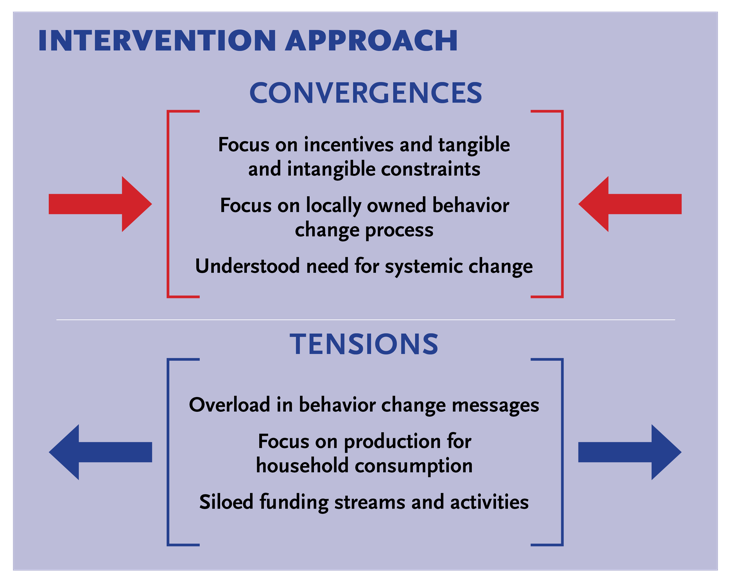
Nutrition activities generally work with PLW and children under two through a cascade approach, by training government staff, local trainers, and community leaders who then train the target population. Nutrition activities commonly draw on and strengthen public- and private-sector and community-based service delivery mechanisms and socially based incentives to foster widespread behavior change. These mechanisms tend to require multiple direct interactions with target beneficiaries and households as well as targeted interventions to support the enabling environment.
Agricultural market development activities work, to the extent possible, through existing market actors. They are implemented mainly through private-sector firms, and leverage commercial incentives to create improvements or change. In this way, activities attempt to stimulate a change process that is locally owned and driven without directly interacting with target farmers or beneficiaries. However, in environments where the private sector is weak and smallholders are an unattractive consumer base, activities may also include actions to directly build the capacity of farmer groups and service providers.
Convergences and Tensions
Decisions about which staff are hired and which partners are engaged are determined by two factors: public- versus private-sector service delivery mechanisms and direct versus indirect interaction with target beneficiaries. Community-oriented staff are often ill-equipped to interact with private businesses, while private sector-oriented staff may not have the profile for effective community engagement. This can lead to a divided implementation approach.
When nutrition-sensitive agricultural market development activities try to work with the public sector, there may be tension between the ministries of agriculture and health, especially in an environment of inadequate support at the highest levels for collaborative planning and resource allocation. Donor funding, similarly, is often designated as supporting either health or agriculture, which can lead to a divided approach to implementation, further challenging any efforts to collaborate around or combine nutrition and agriculture interventions.
Both nutrition and agricultural market development activities seek to change behavior and improve practices. Both types of activities consider the underlying causes of current behavior, incentives, and tangible and intangible barriers to the adoption of recommended behaviors. Furthermore, both types of activities want the behavior change process to be driven by local actors to ensure sustainability. Evidence shows that effective and sustainable behavior change requires more than a household-by-household approach; change needs to be systemic, affecting social norms, structures, and institutions.
When activities promote different behaviors to overlapping groups of people, tensions may arise and cause confusion or overwhelm participants or partners. Using agricultural extension agents to reinforce nutrition messages or community health workers to remind participants of key agricultural behaviors may or may not be successful or logical, depending on the context. Market development programs use a facilitation approach via private-sector firms to change the behavior of various actors, including smallholder farmers. While such firms often have commercial incentives to promote improved production and market behaviors, they may lack the incentive to promote improved nutrition unless a clear business case can be made.
Implications
A focus on behavior change and the process of mapping and leveraging multiple systems actors (in government, agribusinesses, local communities, the media, etc.) to ensure widespread and sustainable change should be central to a nutrition-sensitive agricultural market development activity. It is important to prioritize and sequence behavior change messages so that audiences are able to absorb them. The cross-training of staff and partners in key agricultural and nutritional behavior change messages should be considered when roles, responsibilities, and expectations are clearly defined. In some situations, it may be appropriate for agricultural market development staff to promote nutrition-sensitive agricultural practices through their private-sector partners, or directly with farmer organizations. In other situations, coordinating different types of training and information dissemination may be more appropriate.
Public-private partnerships sometimes have the potential to break down barriers between nutrition and market development actors and activities. Examples include promoting industry-funded national marketing campaigns for nutritious food, developing pluralistic extension services, and facilitating public and private dialogue on food safety standards. Community events such as agricultural fairs and health and wellness campaigns can bring together a range of agribusiness promotion and nutrition education activities and stakeholders.
Where possible, nutrition-sensitive agricultural market development activities should work through commercial actors to ensure sustainability. Activities should leverage commercial incentives for the production, processing, and sale of nutritious foods, in areas where these exist. Where commercial incentives do not exist, facilitators may need to make a business case for investment in the nutritional status of smallholder customers, which may include strengthening consumer advocacy for more nutritional products and increasing pressure on policymakers. Activities may also be able to leverage social and commercial incentives to promote goods and services that encourage positive nutritional outcomes, such as labor-saving technologies for women.
It is important to support public-sector agencies in activities to facilitate the effectiveness of food market systems, such as disease, pest, and nutritional surveillance; food safety monitoring; and building public transport infrastructure.
3. Commercialization of Food
Agriculture and nutrition are both concerned with markets for food, particularly because many smallholder farmers are net buyers of food. In fact, the majority of households targeted by Feed the Future are neither commercial nor subsistence farmers, but are households in transition—producing for consumption and for market. When working with the very poor, nutrition activities often prioritize growing a diverse selection of nutritious food for home consumption, without promoting better market outcomes from the portion of their crops that must be sold for income.
Agricultural market development activities typically promote the production and sale of a small number of crops that have high market demand but may not be nutrient-rich. When nutritious crops are selected, smallholder farmers who previously produced for home consumption may switch to selling these nutritious crops. When selected crops are not nutritious, smallholders may transfer land, labor, and capital resources from the production or preparation of more nutritious crops to focus on the commercial production and marketing of more remunerative crops.
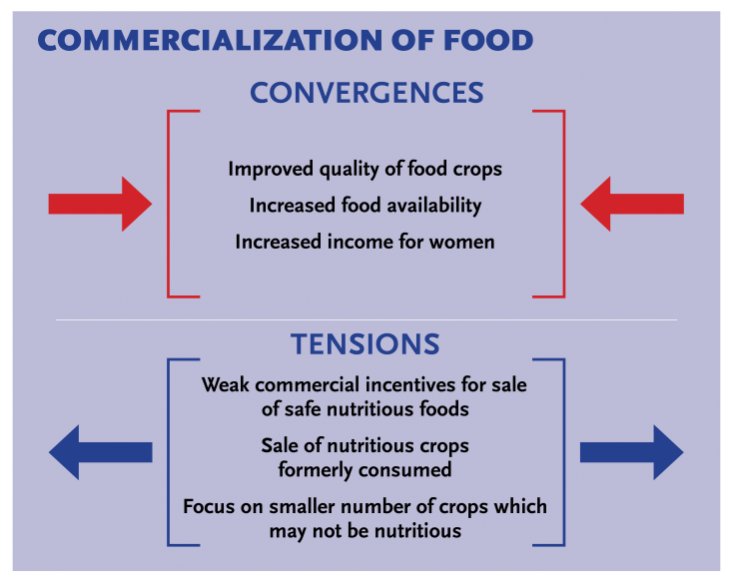
Convergences and Tensions
Agricultural market development activities increase productivity and promote improved on- or off-farm storage to reduce losses, which increases household-level food availability. Agricultural activities working with the poor (should) promote the production and sale of diverse crops in multiple markets, including local, to reduce economic and agronomic risk and increase food availability and variety. It is common for smallholder farmers to sell the highest-quality produce to markets while retaining lower-quality food crops for home consumption. This may be rational for income, but can compromise household food safety and nutrition (e.g., there may be a higher risk of aflatoxin/mycotoxin contamination in lower-quality produce).
Agricultural market development activities often increase the value of products through improved post-harvest handling, storage, packaging, and processing. This may lead to higher incomes, which can contribute to—but do not automatically lead to—improvements in nutritional status. Value addition can also maintain or increase the nutritional quality and safety of the products; for example, through micronutrient fortification or improved drying techniques to prevent contamination. However, some types of "value addition" (e.g., frying food in oil) reduce the nutritional content of food. Without consumer demand or political pressure, there may be little or no incentive for the private sector to sell nutritious food.
Agricultural market development activities typically promote investment in a small number of value chains to maximize economic gains. This approach, however, can increase risk for smallholders, and can reduce the diversity of foods available to the household and local market.
Conversely, when working with the very poor, some donors and ministries prioritize growing nutritious food or raising livestock for home consumption and do not promote market engagement. This may reflect a lack of nutrient-rich crops in the market as a result of weak local demand. Such a focus, however, ignores the important role of markets in sustaining production through the delivery of inputs and services. Market actors can also serve as partners in nutrition-sensitive agriculture activities by creating demand for nutritious products and providing an outlet for surplus production.
Box 3: Gender Resources
Understanding the Women's Empowerment Pathway: Women's empowerment is a key "pathway" to improved household nutrition. The pathway consists of three interrelated components: women's use of income for food and non-food expenditures, the ability of women to care for themselves and their families, and women's energy expenditure (SPRING 2014). Read more here.
Implementation Guide for the Women's Empowerment in Agriculture Index (WEAI): This tool provides guidance to donors and implementers of agricultural market development programs on how to translate into practice the evidence and insights gained from the WEAI survey results (Stern et al. 2015). Read more here.
The commercialization of nutritional food crops traditionally grown by women for household consumption is of particular concern. With commercialization, women may lose control of decisions about the crops they grow and the income from their sale. Women may find themselves working as unpaid laborers for their husbands or other male relatives on land they previously controlled. If women retain control of the crops, however, commercialization can give them access to income. This access, when accompanied by knowledge and an enabling environment, may support improved household nutrition and wellbeing. Because of women's caregiving role in many communities, nutrition and agricultural activities need to be sensitive to increasing demands on women's time and energy.
Implications
Nutrition-sensitive agricultural market development activities should investigate the underlying barriers to improved nutrition and ensure households are encouraged to produce and purchase food for a diverse, balanced diet. Activities can facilitate improved safety and affordability of food in the market, and can strengthen the supply of inputs and services for the production of more diverse nutritious crops. Selecting a portfolio of crops—including cash crops and nutritious crops that can be grown profitably for the market and used for household consumption—can reduce risk for smallholder farmers, particularly where markets are thin.
It is important to incorporate the findings of a gender analysis into activity design, and include interventions to reduce the risk of women losing control of resources or income as food crops are commercialized. It is also crucial to consider incentives, technologies, and innovations that promote time- and labor-saving for women within and across the food system.
Nutrition-sensitive agricultural market development activities should consider using a range of public- and private-sector actors to increase market demand for nutritious crops and animal-source food products such as milk and meat, and to promote the advantages of household consumption. Good agricultural practices that increase food safety (such as the proper use of approved agrochemicals and adherence to withdrawal times before consuming milk and meat from animals treated with antibiotics) should be promoted, as well as interventions that teach nutrition-sensitive processing and food preparation practices. These interventions include the use of potable water, prevention of mycotoxin contamination, and separation of livestock housing from areas frequented by children.
4. Monitoring and Evaluation
Nutrition indicators generally include increased dietary diversity and reductions in stunting, underweight, and wasting. Nutrition-sensitive agricultural development activities may contribute to these results, but are unlikely to directly cause them, particularly in the absence of complementary interventions such as nutrition behavior change communication.3 Indicators for agricultural development activities typically include increases in total production, sales, and incomes. Linking such outcomes to improvements in nutrition is difficult and highly context-specific.
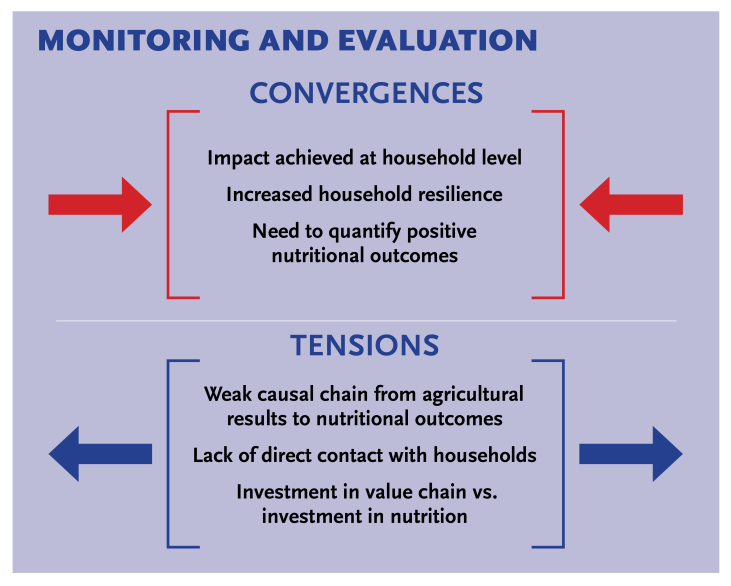
Convergences and Tensions
Both nutrition and agricultural market development activities aim to achieve impact at the household and individual levels, but agriculture activities that use a facilitation approach attempt to achieve household results through systemic change. Such activities often work mainly through private-sector firms and may involve little to no direct contact with households. Private-sector firms often have an incentive to collect sales data on their customers, which can then be used by the activity for monitoring purposes. These firms, however, are unlikely to be able or willing to collect nutrition-related data. Changes at the household or individual level are relatively easy to measure directly but there are no defined methods for measuring systems-level change.
Both nutrition and agricultural market development activities contribute to increased resilience, which can be measured by a range of indicators, such as growth in household assets, linkages to other market actors, and new knowledge and skills. The causal chain from agricultural market development results to nutritional impact, however, is rarely articulated during the activity design process. Even when an activity's theory of change includes one or more pathways between agricultural market development outcomes and nutrition, to date, few activities have tested or monitored these pathways during implementation or evaluated them post-activity (Hawkes and Ruel 2011).
Households conduct informal analyses to balance time and resource investments in activities. Perceived and/or truly positive outcomes such as increased income, productive assets, social capital, and improved health are balanced against the risk and time involved in changing practices and behaviors such as selecting and planting a new crop, investing in and using a new food/crop storage technology, and purchasing and preparing a range of local foods in a new way. The lack of evidence-based nutrition-sensitive agriculture outcome metrics makes it difficult for the development community to know which interventions might be most "valued." There is inherent tension between committing scarce resources to value chain upgrading that is known to result in income increases, and investment in nutrition-sensitive agriculture that may only indirectly contribute to improved nutrition outcomes for children under two years of age and PLW.
Comments Welcome
This Discussion Paper will be updated periodically. Comments from readers are welcome to Kristin O'Planick or Sally Abbott, especially comments that help clarify the information provided or suggest additional information that may be useful.
Implications
Nutrition-sensitive agricultural market development activities should articulate the theory of change, what is within the manageable interest4 of the activity, and causal pathways connecting agriculture and nutrition results. It is important to clearly state assumptions about what other changes need to occur beyond the activity scope. Activities should also include appropriate nutrition-sensitive agriculture indicators to determine effectiveness and build the evidence base. Indicators should account for the timeframe needed to achieve impact, the lack of direct household interaction under a facilitation approach, and the types of interventions included in a market systems activity. Intermediate indicators should be defined and tracked to verify assumptions made in the causal pathway.
Appropriate indicators may relate to consumption of a variety of food groups (dietary diversity); the adoption of promoted nutrition-sensitive agriculture behaviors; the availability, diversity, and cost of nutrient-rich foods in local markets; and the adoption of technologies to reduce women's time and energy burden. Such indicators need to be planned, defined, purposefully designed, and given an appropriate level of attention across implementation, monitoring, and evaluation activities to improve and describe the contribution that agriculture is making to nutrition.
Next Steps
It is clear that much more work is needed to determine how agricultural market development activities can contribute to better nutrition outcomes, and how best to measure those contributions. This brief is intended to stimulate thoughtful debate among designers, managers, and implementers in this field.
This Discussion Paper was produced for the U.S. Agency for International Development, with the support of the Leveraging Economic Opportunities (LEO) project and the Strengthening Partnerships, Results, and Innovations in Nutrition Globally (SPRING) project.
References
Campbell, R. 2014. A Framework for Inclusive Market System Development. Washington, DC: Leveraging Economic Opportunities (LEO) project.
USAID. 2014. Multi-Sectoral Nutrition Strategy Technical Brief: Nutrition-Sensitive Agriculture: Nutrient-Rich Value Chains. Washington, DC: USAID.
Garloch, Anna. 2015. A Framework for a Push/Pull Approach to Inclusive Market Systems Development. Washington, DC: Leveraging Economic Opportunities (LEO) project.
Hawkes, C., and M. T. Ruel. 2011. Value Chains for Nutrition [PDF, 1.7MB]. 2020 Conference Paper 4. Washington, DC: IFPRI.
SPRING. 2014. Understanding the Women's Empowerment Pathway. Brief #4. Improving Nutrition through Agriculture Technical Brief Series. Washington, DC: Strengthening Partnerships, Results, and Innovations in Nutrition Globally (SPRING) project.
Stern, M., L. Jones, and M. Hillesland. 2015. Intervention Guide for the Women's Empowerment in Agriculture Index (WEAI): Practitioners' Guide to Selecting and Designing WEAI Interventions. Washington, DC: Leveraging Economic Opportunities (LEO) project.
Endnotes
1. Facilitation means intervening in a way that stimulates changes in market systems, while avoiding taking a direct role in the system. For example, facilitators may encourage private-sector companies to supply inputs to target beneficiaries, rather than providing those inputs directly.
2. See, for example, Ecker, O., C. Breisinger, and K. Pauw. (2012.) "Growth is Good, but Is Not Enough to Improve Nutrition." In S. Fan and R. Pandya-Lorch (eds.): Reshaping Agriculture for Nutrition and Health: An IFPRI 2020 Book. Washington, DC: International Food Policy Research Institute.
3. See the UNICEF Conceptual Framework
4. The concept of manageable interest recognizes that achievement of results requires joint action on the part of many other actors, such as host country governments, institutions, other donors, civil society, and the private sector. When an objective is within USAID's manageable interest, we have reason to believe that our ability to influence, organize, and support others around commonly shared goals can lead to the achievement of desired results, and that the probability of success is high enough to warrant expending program and staff resources. A result is within an entity's manageable interest when there is sufficient reason to believe that its achievement can be significantly and critically influenced by interventions of that entity (From USAID Automated Directives System, Chapters 200-203).







Comment
Make a general inquiry or suggest an improvement.